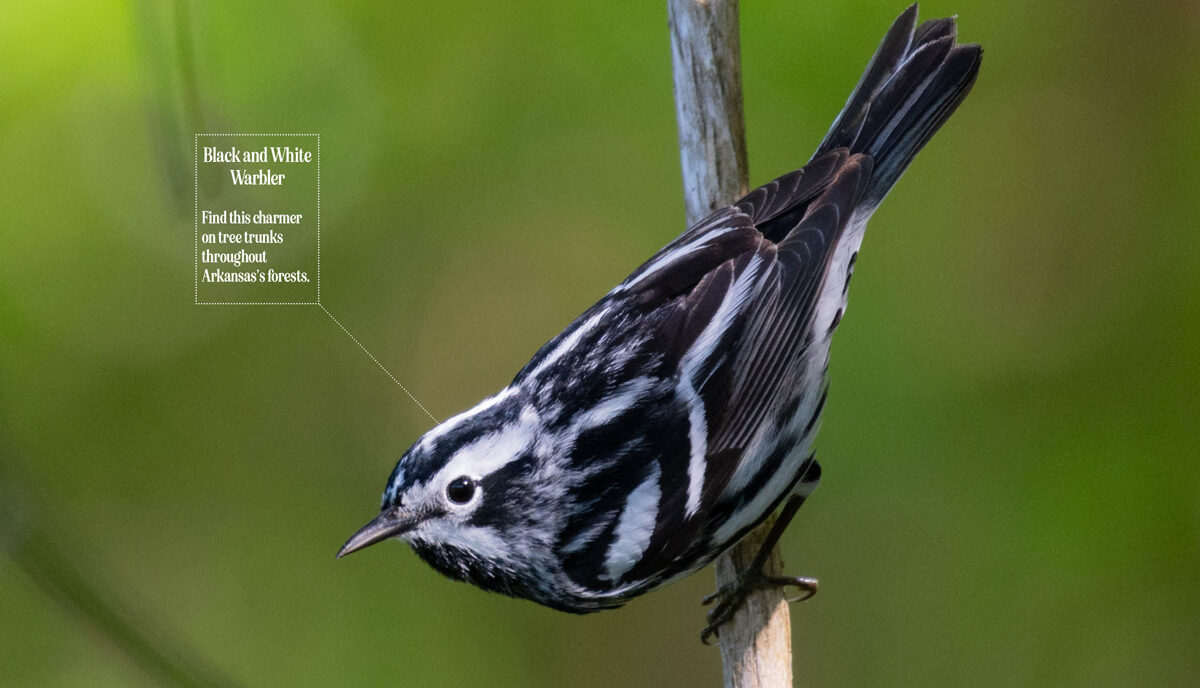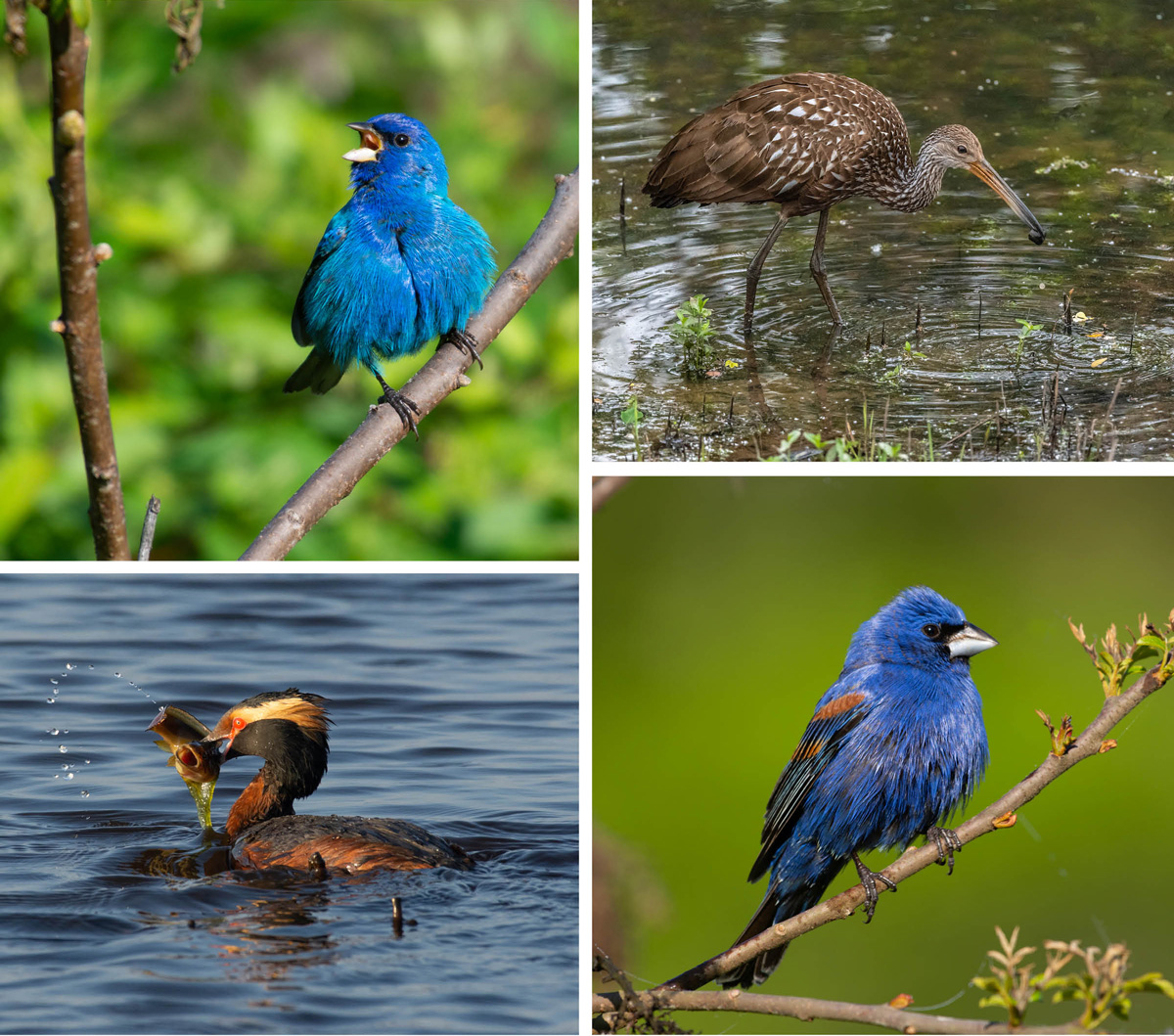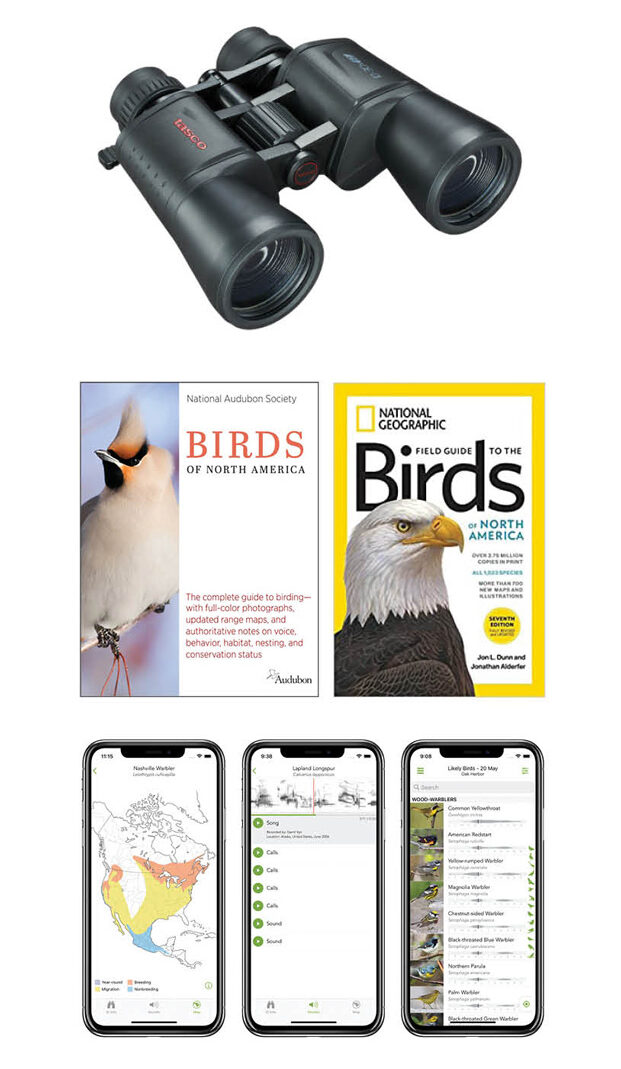A Hobby For Everyone
Incredibly versatile, birdwatching is the perfect activity for anyone
looking to discover the outdoors.
By Becca Bona | Photography By Steven Warmack

Black and White Warbler - Find this charmer on tree trunks throughout Arkansas’s forests.
For as much as people want to get out into nature, there are many things that can get in the way. Expensive equipment, lack of expertise or having to travel considerable distances can all cool a person’s enthusiasm when it comes to traditional outdoor activities such as hunting, fishing or even camping.
Not so with birdwatching, which requires virtually no special equipment, is great for all ages and abilities, and can be done virtually anywhere one is at any given moment. These facts and more make birdwatching — or birding, as the modernists prefer — the perfect gateway activity for anyone wishing to experience the natural world, said Dan Scheiman, Plants for Birds program manager with Audubon Delta.
“Birding is definitely a popular and growing hobby,” he said. “I’ve heard a number of statistics, like it is the second most popular outdoor hobby in the U.S. next to gardening. I’ve heard there are more birdwatchers than there are hunters and anglers combined, although a lot of people who hunt and fish also watch birds. I’ve heard there are more birdwatchers than there are NASCAR fans.
“One of the best things about birdwatching is you can do it anywhere, anytime and it doesn’t necessarily require any kind of equipment. You could be in an apartment, you could be out in the woods, you could be gardening and you could still look at birds and enjoy the presence of birds.”
Like all new activities, success in birding breeds deeper enjoyment and the motivation to continue. Birdwatching affords immediate feedback and gratification, which leads the birder to stay engaged. This can lead people into other activities in search of their pastime.

Baltimore Oriole - Found everywhere in Arkansas, favors elms and open woodlands.

Prothonotary Warbler - Find this flashy creature in river bottom hardwoods and wetlands.
“Birds are all over the place and people who enjoy birdwatching have a desire to see more birds,” Scheiman said. “That leads them to get out to nature and go hiking, go see new parts of the state and new places in the world. [Birding is] a great motivator to get out and explore nature.”
Scheiman recommends people start in areas within easy access, such as their own backyards where some simple steps can kickstart the action.
“I recommend that beginners start with the birds that come to their neighborhood,” he said. “Get a bird feeder, get a field guide, get binoculars if you can and start watching the birds that come to you. Those are the birds that are common, you can see them every day and you have a lot of opportunities to learn how to identify them. Then you can branch out from there.”
Again, unlike fishing where one must travel to a lake or river, or camping, which generally happens outside of areas inhabited by humans, a beginner birder’s world can expand exponentially without traveling a great distance.
“Go to your local park. Go to a nearby national wildlife refuge or wildlife management area and then start expanding your theater,” Scheiman said. “As you’re exploring, you will greatly expand the list of birds you are able to identify.”

CLOCKWISE FROM TOP LEFT: Indigo Bunting - Prefers brushy pastures and edges of woods or swamps. Limpkin - Native to Florida, spot one in freshwater swamps or marshes. Blue Grosbeak - A thicket dweller, look for them in roadside hedgerows or brushy fields. Horned Grebe - Common to Arkansas in winter, this small diver prefers larger lakes and reservoirs.
Scheiman said some common tips for the beginner are really rooted in common sense. Plan your activity in the morning and evening, as birds tend to be more active during these times of day, especially during the peak of summer heat. Look for nocturnal birds, such as owls, at night. Improving the habitat in your backyard will, obviously, draw more specimens so put out food and clean water. Plant selection in your garden will also play a role.
“The best way you can improve your yard for birds is to plant native plants, species that are native to our area that were here before European settlement,” he said. “Those are the plants our birds have evolved with. They are the plants that provide food. They provide the best habitat. They provide places for the birds to nest and to have rest and, most importantly, native plants feed the native insects that feed the birds.”
As for how to actually “do” birdwatching, Scheiman said a little homework and a calm mind are about all it takes to enjoy the activity, be it alone, with a friend or with your children.
“Keep your eyes and ears open. Be patient with yourself. Like any skill, birdwatching takes time to develop and you’re going to make mistakes, but that’s OK,” he said. “Give yourself time to learn the birds; it really helps to go birdwatching with people who are experienced, who can point out a bird and explain the species to you.”

Bobolink - More common locally during migration, bobolinks were nicknamed "ricebirds" for their feeding habits.
FOR THE BIRDS
The ancient practice of birding takes very little equipment compared to other outdoor activities, but there are some things that can help you get started quickly. Dan Scheiman with Audubon Delta suggests the following:

Binoculars – Important for seeing birds’ distinguishing markings close up, binoculars are considered standard equipment, Scheiman said. You can spend a ton on flashier models, but solid entry-level binoculars, such as the Tasco Essentials 8×42, offer solid performance without squawking over the sticker price.
Field Guide – Field guides help you identify the birds you see in the field; even longtime birders swear by their dog-earned printed models. Among the recommended guides is The National Audubon Society’s latest effort, an easy-to-use guide identifying more than 800 species. National Geographic’s field guide is also a highly recommended companion in the field.
Apps – Paper field guides are a wonderful old-school resource, but only an irascible old crow fails to appreciate the value of birding apps. Highly portable and packed with features, these apps quickly ID your bird, assist with birdcall identification, and some even have a built-in digital photo album. For starters, Scheiman suggests Merlin, an intuitive, free app available at the App Store or Google Play.


